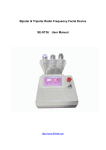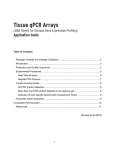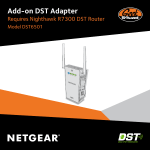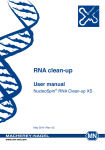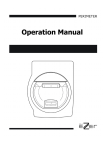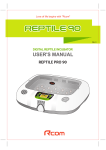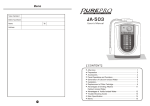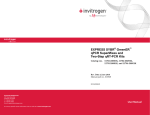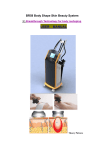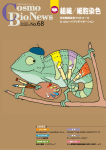Download TissueScan Normal qPCR Arrays - cDNA panels (Human
Transcript
Table of Contents Table of Contents ..................................................................................................................................... 1 Package Contents and Storage Conditions ............................................................................................. 2 Introduction............................................................................................................................................... 3 Production and Quality Assurance........................................................................................................... 4 Experimental Procedures......................................................................................................................... 4 Real-time PCR .....................................................................................................................................................4 Real-time PCR procedure ....................................................................................................................................5 Standard PCR ......................................................................................................................................................6 Troubleshooting Guide ............................................................................................................................. 8 References ............................................................................................................................................... 8 Figures ................................................................................................................................................... 10 Figure 1: TissueScan Human Major Tissue qPCR Array (HMRT102) ................................................................10 Figure 2: HMRT102 Product Quality Control ......................................................................................................11 Figure 3: HMRT102 Product Validation ..............................................................................................................12 Figure 4: TissueScan Human Brain Tissue qPCR Array (HBRT101) .................................................................13 Figure 5: HBRT101 Product Quality Control (real-time PCR).............................................................................14 Figure 6: HBRT101 Product Validation (real-time PCR)....................................................................................15 Figure 7: HBRT101 Product Quality Control and Validation (standard PCR) .....................................................16 Figure 8: TissueScan Mouse Developmental Tissue qPCR Array (MDRT101)..................................................17 Figure 9: MDRT101 Quality Control (real-time PCR)..........................................................................................18 Figure 10: MDRT101 Product Quality Control and Validation (standard PCR)...................................................19 Figure 11: TissueScan Mouse Normal Tissue qPCR Array (MNRT101) ...........................................................20 Figure 12: MNRT101 Quality Control .................................................................................................................21 Figure 13: TissueScan Drosophila Tissue qPCR Array (DSRT101) ...................................................................22 Figure 14: DSRT101 Product Quality Control....................................................................................................23 Figure 15: DSRT101 Product Validation............................................................................................................24 Figure 16: TissueScan Rat Normal Tissue qPCR Array (RNRT101)..................................................................25 Figure 17: RNRT101 Product Quality Control ....................................................................................................26 Figure 18: RNRT101 Product Validation ............................................................................................................27 1 Package Contents and Storage Conditions The following components are included: • Identical, sealed TissueScan™ Tissue qPCR Array plates containing dried, PCR*-ready, firststrand cDNAs • Adhesive cover sheets for sealing the plates • Control primers TissueScanTM Tissue qPCR Arrays Human Major Tissue Human Major Tissue Human Brain Human Brain Mouse Developmental Mouse Developmental Mouse Normal Mouse Normal Rat Normal Rat Normal Drosophila Drosophila Cat. # # of plates provided Control primers HMRT102 HMRT502 HBRT101 HBRT501 Unique samples (format) 48 (4x12) 48 (4x12) 24 (2x12) 24 (2x12) 2 10 2 10 GAPDH GAPDH GAPDH GAPDH MDRT101 48 (4x12) 2 GAPDH MDRT501 48 (4x12) 10 GAPDH MNRT101 MNRT501 RNRT101 RNRT501 DSRT101 DSRT501 36 (3X12) 36 (3X12) 46 (4X12) 46 (4X12) 12 12 2 10 2 10 2 10 GAPDH GAPDH GAPDH GAPDH RpL32 RpL32 The above components are shipped at room temperature, but should be kept at -20°C for long-term storage. If properly stored, they have a 12-month shelf life. The following components are required but are not provided: • • • • Reagents for real-time PCR amplification (e.g., 2x master mix) Gene-specific primers Gene-specific probe (if using a TaqMan Assay) A 96-well real-time thermocycler * The polymerase chain reaction (PCR) is protected by patents held by Hoffmann-La Roche. Purchase of any of OriGene’s PCR-related products does not convey a license to use the PCR process, covered by these patents. Purchasers of these products must obtain a license before performing PCR. NOTE: FOR RESEARCH PURPOSES ONLY. NOT FOR DIAGNOSTIC OR THERAPEUTIC USAGE. 2 Introduction Gene expression profiling is one of the most frequently used approaches for characterizing novel transcripts either derived from expressed sequence tag (EST) projects or the completed human and mouse genomes by means of program prediction. The amount of transcript accumulated in a particular tissue, normal or diseased, often provides valuable information about the function of the gene. Many technologies have been developed for obtaining gene expression data, including Northern blotting, RTPCR and DNA microarray analysis. Each of the technologies has its advantages and disadvantages. The Northern blot method is the only method that reveals the size information of a transcript as well as transcript abundance. The drawback of the method is that it is low-throughput and frequently involves radioactive agents. DNA microarray analysis is a well-established gene expression profiling technology. The primary advantage of DNA microarrays is that it is able to simultaneously generate the expression profiles of thousands of genes. Although DNA microarrays have produced a large amount of useful gene expression data, their sensitivity and accuracy are sometimes compromised by non-specific hybridizations due to shared homology among different genes. Many researchers use RT-PCR to validate the data from microarray experiments. RT-PCR, long used for gene expression profiling, is fast and sensitive. Instead of using hybridization, RNA transcripts are converted to the complementary DNA (cDNA) using a reverse transcription reaction and the cDNAs are subsequently used as the templates for PCR amplification. Thus the amount of PCR product will be correlated to the amount of the original RNA transcript. Previously, OriGene Technologies, Inc. developed a unique PCR-based system, the RapidScan Gene Expression Panel, for fast and accurate gene expression profiling. With serially diluted cDNA templates, the relative amounts of transcript in different tissues could be easily obtained by standard PCR experiments and subsequent agarose gel electrophoresis. This system has been well adopted by the research community. Examples of successful panel usage are cited in numerous publications (1, 2 & http://www.origene.com/support/citations/gene_expression.mspx). With the adoption of realtime PCR technology, many researchers expressed a need for a real-time PCR or quantitative PCR (qPCR) version of the RapidScan product. To accommodate this need, we have developed the TissueScan Tissue qPCR Arrays using the same high quality cDNAs as those used in the RapidScan panels. OriGene’s TissueScan Real-Time qPCR Arrays have gone through vigorous quality control and validation. Unlike the RapidScan gene expression panels, the TissueScan qPCR arrays contain only one concentration of cDNAs, normalized to a housekeeping gene. Benefits of the Tissue qPCR Array include: • Fast and non-radioactive (no radiolabeling of probe/no blot hybridization/ no filter washing) • Instant expression data; no agarose gel electrophoresis required • Simultaneous examination of a wide range of different tissues and/or developmental stages • Highly sensitive and quantitative • Extremely reliable 3 Production and Quality Assurance TissueScan Tissue qPCR Arrays were assembled by selecting frequently studied tissues and/or developmental stages. To avoid detection of individual differences in gene expression, tissues were pooled, whenever possible, from multiple individuals. For the human panels, tissues were selected from individuals of different ethnicity. For the mouse panels, the tissues were derived from NIH Swiss mice. The Drosophila panels were derived from samples from the Canton S strain. Total RNA was isolated and subjected to oligo(dT) selection. The recovered poly A+ RNA was then examined by Northern blot hybridization to confirm RNA integrity. The poly A+ RNA was used to synthesize first-strand cDNA, using oligo(dT) primers and M-MLV reverse transcriptase. Individual cDNA pools were confirmed to be free of genomic DNA contamination and to contain complete reverse transcripts of selected rare and long mRNAs, such as those for the transferrin receptor (5 kb) and the ataxia telangiectasia gene (9.4 kb). The first-strand cDNAs from each tissue were then subjected to normalization, such that they all contain an equivalent concentration of GAPDH cDNA for human and mouse samples, or RpL32 cDNA for Drosophila samples. Experimental Procedures Real-time PCR Real-time PCR continuously quantifies the PCR product throughout the entire thermocycling process. Therefore, it eliminates the need for agarose gel quantification and avoids the issue of saturated images of PCR products normally encountered in standard PCR quantitation. This is achieved via comparison of the data during the linear amplification phase. TaqMan probe (3) and SYBR Green I (4, 5) based protocols are the most commonly used real-time PCR protocols. These methods generate fluorescent signals that are proportional to the amount of the PCR products generated at the end of each cycle. Differences among them involve the types of signals and the method by which the fluorescent signals are generated. In a TaqMan protocol, a pair of gene-specific primers and a sequence-specific, fluorogenic probe (with reporter and quencher) is included in the PCR mix. The specific probe anneals proportionally to the single stranded DNA and as DNA synthesis occurs, is subsequently removed base-by-base by the 5’ exonuclease activity of Taq polymerase. Consequentially, the released fluorescent reporter is freed from the quencher, and generates a fluorescent signal that is proportional to the amount of PCR product being accumulated. This method is very sensitive and reliable. A SYBR Green I protocol, on the other hand, does not require a fluorescent probe. SYBR Green I binds to double stranded DNA to generate detectable fluorescence, and the amount of signal is proportional to the amount of double stranded DNA in solution. Since SYBR Green I binds indiscriminately to double stranded DNAs, it will generate false signals if non-specific elements (e.g., primer dimers) exist. This is frequently used in many laboratories due to its simplicity and low cost. Both TaqMan and SYBR Green I protocols can be used with the TissueScan Tissue qPCR Array. Gene specific primers and probes A successful real-time PCR detection requires a set of sequence-specific primers (and may require a fluorescent probe, as described above). Many primer and probe designing programs are commercially available, or are found as freeware on the internet. It is suggested that qPCR amplicons should range from 80-150 base pairs in length. When using the SYBR Green I protocol, since the fluorescence signal reflects the total amount of double stranded DNA (including specific and non-specific products), it is critical to design primers that maximize specific products and minimize non-specific products. We recommend optimizing PCR primers and conditions using known templates before the PCR system is used with the TissueScan Tissue qPCR Array. 4 PCR master mix Both TaqMan and SYBR Green I master mixes are commercially available and are recommended for use in the TissueScan Tissue qPCR Array. A real-time PCR master mix usually contains PCR buffer, magnesium, dNTPs and Taq polymerase. Most commercially available real-time master mixes are provided as a 2X concentration with a reference dye (ROX) included. Real-time PCR thermocycler A 96-well real-time thermocycler and detection system is required for using the TissueScan Tissue qPCR Array. The machines listed in the following table are compatible with these panels. For devices not listed in the table, please contact OriGene for suggestions. Manufacturer ABI Bio-Rad Stratagene Model Prism 7000, 7700, 7300, 7500, 9500 iCycler, MyiQ Mx4000, Mx3000p, Mx3005p Real-time PCR procedure Remove the TissueScan plate from –20ºC storage and allow it to warm to room temperature. Prepare a pre-mix in a 1.5 ml tube according to the recipe below. For SYBR Green I protocols: 24 samples 36 samples 48 samples Stock solution 2X master mix Forward primer (10 pmol/µL) Reverse primer (10 pmol/µL) ddH2O Volume 390 µL 26 µL 26 µL 338 µL Volume 570 µL 38 µL 38 µL 494 µL Volume 750 µL 50 µL 50 µL 650 µL Total 780 µL 1140 µL 1500 µL For TaqMan protocols: 24 samples 36 samples 48 samples Stock solution 2X master mix Forward primer (10 pmol/µL) Reverse primer (10 pmol/µL) 20X TaqMan probe ddH2O Volume 390 µL 26 µL 26 µL 39 µL 299 µL Volume 570 µL 38 µL 38 µL 57 µL 437 µL Volume 750 µL 50 µL 50 µL 75 µL 575 µL Total 780 µL 1140 µL 1500 µL • • • Final 1X 10 pmol/well 10 pmol/well Final 1X 10 pmol/well 10 pmol/well 1X Remove the sealing film from the plate. Aliquot 30 µL of the PCR pre-mix into each well, avoiding cross-contamination during pipetting. This can best be achieved using a multi-channel pipettor after equally dividing the 1.5 ml premix into PCR tubes. Cover the top of the plate with a new adhesive cover sheet (provided). Seal each well tightly by pressing the cover around each well. Remove any air bubbles that may have been trapped at the bottom of the tubes by gently tapping the plate on a flat surface. Incubate the plate on ice for 15 minutes to allow the dried cDNA to dissolve. Gently vortexing the plate will facilitate resuspension of the DNA. Mount the plate snugly into the 96-well real-time thermal cycler, so that each well makes tight contact with the heating unit. Tighten the lid of the thermal cycler to ensure direct contact between the lid and 5 • • • the top of the plate; this will reduce the chance of evaporation from the wells. These steps are very critical for even template amplification. Program the thermal cycling conditions optimized for your gene-specific primers. Set the reporter type (TaqMan probe or SYBR Green I and reference dye) according to the equipment user’s guide. If a SYBR Green I protocol is used, program a post-amplification melting curve test if possible. The following cycling conditions are listed here as a reference; we strongly suggest that the cycling conditions be optimized for your gene-specific primers. Activation Pre-soak 42 cycles of: Denaturation Annealing 50°C for 2 min 95°C for 5 min 95°C for 15 sec 60°C for 1 min Note: for an amplicon > 120 bp, a 72°C extension step must be incorporated. • Analyze the expression data using the software provided by the thermal cycler manufacturer. In most cases, relative expression levels can be calculated (6). Use your own preferred method to perform this analysis. • Examine the PCR products via 2% agarose gel if desired (recommended when a SYBR Green I protocol is used for detection). Standard PCR Although the TissueScan Tissue qPCR Array is designed for real-time PCR procedures, it can also be used in a standard PCR protocol using agarose gel electrophoresis. Semi-quantitative analysis is desirable when researchers prefer to use gel documentation data for publication. An experimental procedure for standard PCR is described below. Primer design for standard PCR Primer design is a critical factor in obtaining success in PCR. There are no simple rules; however, the general guidelines for primer design indicate that primers should be between 17 and 25 nucleotides in length, have a G/C content of approximately 50% and should not form strong secondary structures. Avoid sequences that are susceptible to primer-dimer formation. In addition, the primers should ideally correspond to the coding region of the gene of interest. The positions of the forward and the reverse primers should be between 300 and 1000 bp apart, so as to facilitate efficient template amplification and easy detection of the PCR product in an agarose gel. If possible, a pilot PCR amplification should be performed using the gene-specific primers and a test template, such as a plasmid cDNA clone or a first-strand cDNA preparation that is known to contain the target sequence of interest. 6 Standard PCR procedure Remove the TissueScan plate from -20°C storage and allow it to warm to room temperature. Prepare a PCR pre-mix* according to the following recipe 24 samples 36 samples 48 samples Stock solution 10X PCR buffer dNTPs (2 mM each) Forward primer (10 pmol/µL) Reverse primer (10 pmol/µL) Taq DNA polymerase (5 U/µL) ddH2O Volume 78 µL 78 µL 26 µL 26 µL 2.6 µL 569.4 µL Volume 114 µL 114 µL 38 µL 38 µL 3.8 µL 832.2 µL Volume 150 µL 150 µL 50 µL 50 µL 5 µL 1095 µL Total 780 µL 1140 µL 1500 µL • • • • • Final 1X 0.2 mM 10 pmol/well 10 pmol/well 0.5 U/well Remove the sealing film from the TissueScan plate. Aliquot 30 µL of the PCR pre-mix into each well, avoiding cross-contamination during pipetting. This can best be achieved using a multichannel pipettor. Cover the top of the plate with a new adhesive cover sheet (provided). Seal each well tightly by pressing the cover around each well. Remove any air bubbles that may have been trapped at the bottom of the tubes by gently tapping the plate on a flat surface. Incubate the plate on ice for 15 minutes to allow the dried cDNA to dissolve. Gently vortexing the plate facilitates resuspension of the DNA. Mount the plate snugly into the block of a 96-well thermal cycler, so that each well makes tight contact with the heating unit. Tighten the lid of the thermal cycler to ensure direct contact between the lid and the top of the plate; this will reduce the chance of evaporation from the wells. These steps are very critical for even template amplification. Program the thermal cycling conditions optimized for your gene-specific primers. The following cycling conditions are listed here as a reference; we strongly suggest that the cycling conditions be optimized for your gene-specific primers: Pre-soak 33* cycles of: Denaturation Annealing Extension Soak 94°C for 3 min 94°C for 30 sec 55°C for 30 sec** 72°C for 2 min 72°C for 5 min * Use 31 cycles for the control primers and run a 2% agarose gel to obtain the results shown in Fig. 3. For your target gene, set the cycle number based on the abundance of the transcript (if known). ** This is the suggested annealing temperature for the GAPDH control primers. The annealing temperature should be 5°C below that of the Tm of the gene-specific primers. • • • When the reaction is completed, remove the cover sheet and add to each well 15 µL of 3X DNA loading buffer. Mix gently by pipetting up and down. Load 15 µL of each sample onto the gel. Store the remaining samples at –20°C. Separate the samples by electrophoresis and document the results. Positive control PCR Two identical TissueScan plates are provided for your convenience. Ideally, the two plates may be used for the analysis of two different genes or ESTs. Alternatively, after obtaining an adequate expression 7 profile for a test gene, the second plate may be used for determining the expression profile using the control primers provided. To perform the control PCR, substitute the gene-specific primers with 100 µL of the control primers (GAPDH for human and mouse panels, RpL32 for Drosophila panels). The single primer tube contains both the forward and reverse primers. These primer pair has been optimized for a SYBR Green I protocol. The expected sizes of the PCR products from the control primers are listed below. human GAPDH product: 151 bp mouse GAPDH product: 151 bp Drosophila RpL32 product: 434 bp Sample profiling The cDNAs in every TissueScan qPCR panel have been vigorously quality controlled. The cDNAs were normalized to GAPDH or RpL32 content, and tested to confirm normalization using those same primers with a SYBR Green I protocol (Figs 2, 5, 9, 12, 14). The panels are also tested both in real-time PCR and in standard PCR (Figs 3, 6, 7, 10, 15). Troubleshooting Guide No PCR product detected May have omitted a PCR component. Be sure to use a written checklist when assembling the reaction mix. May have used an inappropriate annealing temperature. If at all possible, test primers against a known template (e.g., diluted cloned DNA) to determine the optimal amplification conditions. May be due to poor primer design. Follow the general guidelines when designing PCR primers. More than one PCR product detected on an agarose gel It is possible that all of the products are specific, resulting from the amplification of either alternatively spliced mRNAs or transcripts derived from distinct members of a gene family. This may be resolved by either DNA sequencing of the PCR products or by using nested PCR primers for reamplification. Detection of both specific band(s) and a background smear This may be the result of the annealing temperature used in the experiment, giving rise to both specific component(s) and non-specific background noise. The non-specific components may be reduced by increasing the stringency of the PCR amplification. References 1. Khong HT, Rosenberg SA. The Waardenburg syndrome type 4 gene, SOX10, is a novel tumor-associated antigen identified in a patient with a dramatic response to immunotherapy. Cancer Res. 2002 Jun 1; 62(11):3020-3. 2. Egland KA, Kumar V, Duray P, Pastan I. Characterization of overlapping XAGE-1 transcripts encoding a cancer testis antigen expressed in lung, breast and other types of cancers. Mol Cancer Ther. 2002 May; 1(7):441-50. 8 3. Lee LG, Connell CR, Bloch W. (1993). Allelic discrimination by nick-translation PCR with fluorogenic probes. Nucleic Acids Res.11; 21(16):3761-6. 4. T.B. Morrison, J.J. Weis, C.T. (1998). Quantification of Low-Copy Transcripts by Continuous SYBR Green I Monitoring during Amplification. BioTechniques 24, 954 (1998). 5. K.M. Ririe, R.P. Rasmussen, C.T. Wittwer. (1997). Product Differentiation by Analysis of DNA Melting Curves during the Polymerase Chain Reaction. Anal Biochem. 245, 154. 6. M.W. Pfaffl, A new mathematical model for relative quantification in real-time RT-PCR. (2001). Nucleic Acids Research 2001 29:2002-2007. 9 Figures Figure 1: TissueScan Human Major Tissue qPCR Array (HMRT102) Location C-1 C-2 C-3 C-4 C-5 C-6 C-7 C-8 C-9 C-10 C-11 C-12 D-1 D-2 D-3 D-4 D-5 D-6 D-7 D-8 D-9 D-10 D-11 D-12 Tissue Adrenal Gland Bone Marrow Brain Cervix Colon Descending part of duodenum Epididymis Esophagus Fat Heart Intestine (Small) Intracranial Artery Kidney Liver Lung Lymph Node PBL (plasma blood leucocytes) Mammary gland Muscle Nasal Mucosa Optic Nerve Ovary Oviduct Pancreas 10 Location E-1 E-2 E-3 E-4 E-5 E-6 E-7 E-8 E-9 E-10 E-11 E-12 F-1 F-2 F-3 F-4 F-5 F-6 F-7 F-8 F-9 F-10 F-11 F-12 Tissue Penis Pericardium Pituitary Placenta Prostate Rectum Retina Seminal Vesicles Skin Spinal Cord Spleen Stomach Testis Thymus Thyroid Tongue Tonsil Trachea Urethra Urinary Bladder Uterus Uvula Vagina Vena Cava Figure 2: HMRT102 Product Quality Control Figure 2. The Human Major Tissue qPCR Array used in a real-time PCR protocol in a PE7700 thermal cycler using GAPDH primers. The GAPDH amplification products were detected using the SYBR Green I protocol, then run on an agarose gel. The sample numbers in the bottom panel correspond to the cDNA templates listed in Figure 1. Top panel: Real-time PCR results (fluorescence readings) Lower panel: PCR products on 2% agarose gel stained with ethidium bromide 11 Figure 3: HMRT102 Product Validation 800.0 700.0 600.0 500.0 Relative Expression Level 400.0 300.0 200.0 100.0 1 2 3 4 5 6 7 8 9 10 11 12 13 14 15 16 17 18 19 20 21 22 23 24 25 26 27 28 29 30 31 32 33 34 35 36 37 38 39 40 41 42 43 44 45 46 47 48 0.0 Sample number Figure 3. The Human Major Tissue qPCR Array used in a real-time PCR protocol in a PE7700 thermal cycler using primers designed against the human thyroglobulin gene. The sample numbers in the bottom panel correspond to the cDNA templates listed in Figure 1. Top panel: Real-time PCR results (fluorescence readings) Lower panel: Normalized relative expression levels among 48 tissue samples. 12 Figure 4: TissueScan Human Brain Tissue qPCR Array (HBRT101) Location C-1 C-2 C-3 C-4 C-5 C-6 C-7 C-8 C-9 C-10 C-11 C-12 Tissue Frontal Lobe Temporal Lobe Occipital Lobe Parietal Lobe Paracentral Gyrus Postcentral Gyrus Olfactory Bulb Thalamus Corpus Callosum Hypothalamus Amygdala Hippocampus Location D-1 D-2 D-3 D-4 D-5 D-6 D-7 D-8 D-9 D-10 D-11 D-12 13 Tissue Caudate Putamen Substantia Nigra Pituitary Gland Cerebellum grey Cerebellum white Cerebellum vermis Nucleus Accumbens Pons Medulla Spinal Cord Choroid Plexus Figure 5: HBRT101 Product Quality Control (real-time PCR) Figure 5. The Human Brain Tissue qPCR Array used in a real-time PCR protocol in a PE7700 thermal cycler using GAPDH primers. The GAPDH amplification products were detected using the SYBR Green I protocol. 14 Figure 6: HBRT101 Product Validation (real-time PCR) 700.00 600.00 500.00 400.00 300.00 200.00 100.00 0.00 1 2 3 4 5 6 7 8 9 10 11 12 13 14 15 16 17 18 19 20 21 22 23 24 Relative Expression Level Sample number Figure 6. The Human Brain Tissue qPCR Array used in a real-time PCR protocol in a PE7700 thermal cycler using primers designed against the human growth hormone releasing hormone receptor (GHRHR) (NM_001009824). The sample numbers in the bottom panel correspond to the cDNA templates listed in Figure 4. Top panel: Real-time PCR results (fluorescence readings) Lower panel: Normalized relative expression levels among 48 tissue samples. 15 Figure 7: HBRT101 Product Quality Control and Validation (standard PCR) 1 2 3 4 5 6 7 8 9 10 11 12 13 14 15 16 17 18 19 20 21 22 23 24 1 2 3 4 5 6 Figure 7. The Human Brain Tissue qPCR Array used in a standard PCR protocol using the primers indicated below. The amplification products were run on an agarose gel stained with ethidium bromide. The sample numbers in each panel correspond to the cDNA templates listed in Figure 4. Row 1. NM_001101 Homo sapiens GAPDH Row 2. NM_001009824 Homo sapiens growth hormone releasing hormone receptor (GHRHR) Row 3. NM_033207 Homo sapiens transmembrane protein 10 Row 4. NM_000816 Homo sapiens gamma-aminobutyric acid (GABA) A receptor Row 5. NM_005458 Homo sapiens GABA-B receptor Row 6. NM_000832 Homo sapiens NMDA receptor subunit (NR1) 16 Figure 8: TissueScan Mouse Developmental Tissue qPCR Array (MDRT101) Location C-1 C-2 C-3 C-4 C-5 C-6 C-7 C-8 C-9 C-10 C-11 C-12 D-1 D-2 D-3 D-4 D-5 D-6 D-7 D-8 D-9 D-10 Tissue Embryo Day 13 Telencepahlon/ Diencephalon Mesencephelon (Midbrain) Rhombencephalon (Hindbrain) Spinal Cord Embryo Day 15 Telencephalon Diencephalon Midbrain Pons Medulla Spinal Cord Embryo Day 18 Frontal Cortex Posterior Cortex Entorhinal Cortex Olfactory Bulb Hippocampus Striatum Thalamus Hypothalamus Midbrain Pons Medulla Spinal Cord 17 Location D-11 D-12 E-1 E-2 E-3 E-4 E-5 E-6 E-7 E-8 E-9 E-10 E-11 E-12 F-1 F-2 F-3 F-4 F-5 F-6 F-7 F-8 F-9 F-10 F-11 F-12 Tissue Postnatal Day 7 Frontal Cortex Posterior Cortex Entorhinal Cortex Olfactory Bulb Hippocampus Striatum Thalamus Hypothalamus Cerebellum Midbrain Pons Medulla Spinal Cord Adult 5 Week Frontal Cortex Posterior Cortex Entorhinal Cortex Olfactory Bulb Hippocampus Striatum Thalamus Hypothalamus Cerebellum Midbrain Pons Medulla Spinal Cord Figure 9: MDRT101 Quality Control (real-time PCR) Figure 9. The TissueScan Mouse Developmental Tissue qPCR Array used in a real-time PCR protocol in a PE7700 thermal cycler using GAPDH primers. The GAPDH amplification products were detected using the SYBR Green I protocol, then run on an agarose gel. Top panel: Real-time PCR results (fluorescence readings) Lower panel: PCR products on 2% agarose gel stained with ethidium bromide 18 Figure 10: MDRT101 Product Quality Control and Validation (standard PCR) 1 2 3 4 5 6 7 8 9 10 11 12 13 14 15 16 17 18 19 20 21 22 23 24 25 26 27 28 29 30 31 32 33 34 35 36 37 38 39 40 41 42 43 1 2 3 Figure 10. The TissueScan Mouse Developmental Tissue qPCR Array used in a standard PCR protocol using the primers indicated below. The amplification products were run on an agarose gel stained with ethidium bromide. Row 1. NM_001101 Mouse GAPDH Row 2. NM_003235 Mouse Hox 3.1 Row 3. NM_014357 Mouse Dopamine receptor D3 19 Figure 11: TissueScan Mouse Normal Tissue qPCR Array (MNRT101) 20 Figure 12: MNRT101 Quality Control Figure 12. TissueScan Mouse Normal Tissue used in a real-time PCR protocol in a PE7700 thermal cycler using GAPDH primers. The GAPDH amplification products in were detected using the SYBR Green I protocol. 21 Figure 13: TissueScan Drosophila Tissue qPCR Array (DSRT101) Well C-1 C-2 C-3 C-4 C-5 C-6 C-7 C-8 C-9 C-10 C-11 C-12 Tissue Embryo 0-4 hours Embryo 4-8 hours Embryo 8-12 hours Embryo 12-24 hours 1st instar 2nd instar 3rd instar Pupae Male eye/ head Female eye/ head Male body Female body Well D-1 D-2 D-3 D-4 D-5 D-6 D-7 D-8 D-9 D-10 D-11 D-12 22 Tissue Embryo 0-4 hours Embryo 4-8 hours Embryo 8-12 hours Embryo 12-24 hours 1st instar 2nd instar 3rd instar Pupae Male eye/ head Female eye/ head Male body Female body Figure 14: DSRT101 Product Quality Control Figure 14. The Drosophila Tissue qPCR Array used in a real-time PCR protocol in a PE7700 thermal cycler using primers designed against ribosomal protein RpL32. The amplification products were detected using the SYBR Green I protocol, then run on an agarose gel. Top panel: Real-time PCR results (fluorescence readings) Lower panel: PCR products on 2% agarose gel stained with ethidium bromide 23 Figure 15: DSRT101 Product Validation 1200 1000 800 Relative Expression Level 600 400 200 0 1 2 3 4 5 6 7 8 9 10 11 12 Sample number Figure 15. The Drosophila Tissue qPCR Array used in a real-time PCR protocol in a PE7700 thermal cycler using primers designed against the doublesex gene. The sample numbers in the bottom panel correspond to the cDNA templates listed in Figure 13. Top panel: Real-time PCR results (fluorescence readings) Lower panel: Normalized relative expression levels among 12 tissue samples. 24 Figure 16: TissueScan Rat Normal Tissue qPCR Array (RNRT101) Location C-1 C-2 C-3 C-4 C-5 C-6 C-7 C-8 C-9 C-10 C-11 C-12 D-1 D-2 D-3 D-4 D-5 D-6 D-7 D-8 D-9 D-10 D-11 D-12 Tissue Adipose Tissue Adrenal Gland Aorta Bladder Brain, Brainstem Brain, Cerebellum Brain, Cerebral Cortex Brain, Front Cortex Brain, Medulla Brain, Midbrain Brain, Pons Brain, Posterior Cortex Brain, Thalamus Brain, Whole Embryo-E12 Embryo-E15 Embryo-E17 Embryo-E19 Epididymis Esophagus Heart Intestine Kidney Liver Location E-1 E-2 E-3 E-4 E-5 E-6 E-7 E-8 E-9 E-10 E-11 E-12 F-1 F-2 F-3 F-4 F-5 F-6 F-7 F-8 F-9 F-10 25 Tissue Lymph Nodes Mammary Gland, day1 of involution Mammary Gland, day1 of lactation Mammary Gland, non-pregnant Mammary Gland, pregnant-E12 Mammary Gland, pregnant-E16 Ovary Pancreas Pituitary Placenta Prostate Skeletal Muscle Skin Spinal Cord Spleen Stomach Striatum Testis Thymus Thyroid Trachea Uterus, non-pregnant Figure 17: RNRT101 Product Quality Control Figure 17. The Rat Normal Tissue qPCR Array used in a real-time PCR protocol in a PE7700 thermal cycler using GAPDH primers. The GAPDH amplification products were detected using the SYBR Green I protocol, then run on an agarose gel. The sample numbers in the bottom panel correspond to the cDNA templates listed in Figure 16. Top panel: Real-time PCR results (fluorescence readings) Lower panel: PCR products on 2% agarose gel stained with ethidium bromide 26 Figure 18: RNRT101 Product Validation 700 600 500 Relative Expression Level 400 300 200 100 1 2 3 4 5 6 7 8 9 10 11 12 13 14 15 16 17 18 19 20 21 22 23 24 25 26 27 28 29 30 31 32 33 34 35 36 37 38 39 40 41 42 43 44 45 46 0 Sample number Figure 18. The Rat Normal Tissue qPCR Array used in a real-time PCR protocol in a PE7700 thermal cycler using primers designed against the rat LOC299907(XM_216920) gene. The sample numbers in the bottom panel correspond to the cDNA templates listed in Figure 16. Top panel: Real-time PCR results (fluorescence readings) Lower panel: Normalized relative expression levels among 46 tissue samples. 27



























